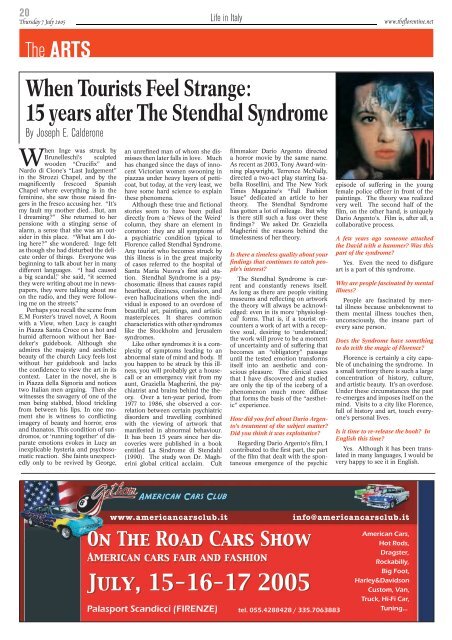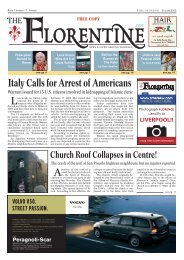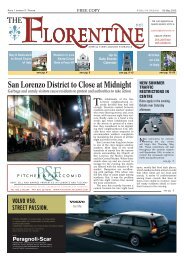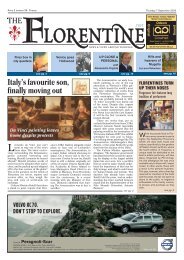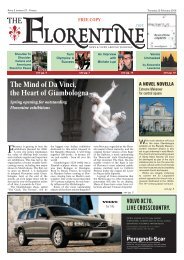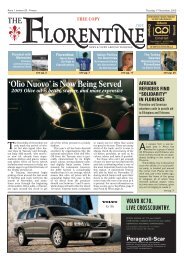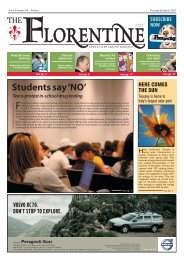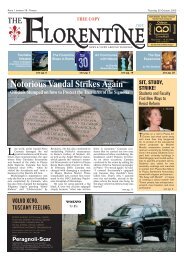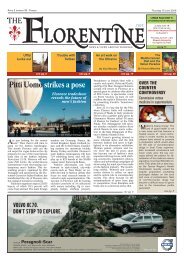Topless in Tuscany Not Tolerated - The Florentine
Topless in Tuscany Not Tolerated - The Florentine
Topless in Tuscany Not Tolerated - The Florentine
You also want an ePaper? Increase the reach of your titles
YUMPU automatically turns print PDFs into web optimized ePapers that Google loves.
20<br />
Thursday 7 July 2005<br />
<strong>The</strong> ARTS<br />
Life <strong>in</strong> Italy<br />
www.theflorent<strong>in</strong>e.net<br />
When Tourists Feel Strange:<br />
15 years after <strong>The</strong> Stendhal Syndrome<br />
By Joseph E. Calderone<br />
When Inge was struck by<br />
Brunelleschi’s sculpted<br />
wooden “Crucifix” and<br />
Nardo di Cione’s “Last Judgement”<br />
<strong>in</strong> the Strozzi Chapel, and by the<br />
magnificently frescoed Spanish<br />
Chapel where everyth<strong>in</strong>g is <strong>in</strong> the<br />
fem<strong>in</strong><strong>in</strong>e, she saw those raised f<strong>in</strong>gers<br />
<strong>in</strong> the fresco accus<strong>in</strong>g her. “It’s<br />
my fault my mother died…But, am<br />
I dream<strong>in</strong>g?” She returned to her<br />
pensione with a st<strong>in</strong>g<strong>in</strong>g sense of<br />
alarm, a sense that she was an outsider<br />
<strong>in</strong> this place. “What am I do<strong>in</strong>g<br />
here?” she wondered. Inge felt<br />
as though she had disturbed the delicate<br />
order of th<strong>in</strong>gs. Everyone was<br />
beg<strong>in</strong>n<strong>in</strong>g to talk about her <strong>in</strong> many<br />
different languages. “I had caused<br />
a big scandal,” she said, “it seemed<br />
they were writ<strong>in</strong>g about me <strong>in</strong> newspapers,<br />
they were talk<strong>in</strong>g about me<br />
on the radio, and they were follow<strong>in</strong>g<br />
me on the streets.”<br />
Perhaps you recall the scene from<br />
E.M Forster’s travel novel, A Room<br />
with a View, when Lucy is caught<br />
<strong>in</strong> Piazza Santa Croce on a hot and<br />
humid afternoon without her Baedeker’s<br />
guidebook. Although she<br />
admires the majesty and aesthetic<br />
beauty of the church Lucy feels lost<br />
without her guidebook and lacks<br />
the confidence to view the art <strong>in</strong> its<br />
context. Later <strong>in</strong> the novel, she is<br />
<strong>in</strong> Piazza della Signoria and notices<br />
two Italian men argu<strong>in</strong>g. <strong>The</strong>n she<br />
witnesses the savagery of one of the<br />
men be<strong>in</strong>g stabbed, blood trickl<strong>in</strong>g<br />
from between his lips. In one moment<br />
she is witness to conflict<strong>in</strong>g<br />
imagery of beauty and horror, eros<br />
and thanatos. This condition of sundromos,<br />
or ‘runn<strong>in</strong>g together’ of disparate<br />
emotions evokes <strong>in</strong> Lucy an<br />
<strong>in</strong>explicable hysteria and psychosomatic<br />
reaction. She fa<strong>in</strong>ts unexpectedly<br />
only to be revived by George,<br />
an unref<strong>in</strong>ed man of whom she dismisses<br />
then later falls <strong>in</strong> love. Much<br />
has changed s<strong>in</strong>ce the days of <strong>in</strong>nocent<br />
Victorian women swoon<strong>in</strong>g <strong>in</strong><br />
piazzas under heavy layers of petticoat,<br />
but today, at the very least, we<br />
have some hard science to expla<strong>in</strong><br />
these phenomena.<br />
Although these true and fictional<br />
stories seem to have been pulled<br />
directly from a ‘News of the Weird’<br />
column, they share an element <strong>in</strong><br />
common: they are all symptoms of<br />
a psychiatric condition typical to<br />
Florence called Stendhal Syndrome.<br />
Any tourist who becomes struck by<br />
this illness is <strong>in</strong> the great majority<br />
of cases referred to the hospital of<br />
Santa Maria Nuova’s first aid station.<br />
Stendhal Syndrome is a psychosomatic<br />
illness that causes rapid<br />
heartbeat, dizz<strong>in</strong>ess, confusion, and<br />
even halluc<strong>in</strong>ations when the <strong>in</strong>dividual<br />
is exposed to an overdose of<br />
beautiful art, pa<strong>in</strong>t<strong>in</strong>gs, and artistic<br />
masterpieces. It shares common<br />
characteristics with other syndromes<br />
like the Stockholm and Jerusalem<br />
syndromes.<br />
Like other syndromes it is a complexity<br />
of symptoms lead<strong>in</strong>g to an<br />
abnormal state of m<strong>in</strong>d and body. If<br />
you happen to be struck by this illness,<br />
you will probably get a housecall<br />
or an emergency visit from my<br />
aunt, Graziella Magher<strong>in</strong>i, the psychiatrist<br />
and bra<strong>in</strong>s beh<strong>in</strong>d the theory.<br />
Over a ten-year period, from<br />
1977 to 1986, she observed a correlation<br />
between certa<strong>in</strong> psychiatric<br />
disorders and travell<strong>in</strong>g comb<strong>in</strong>ed<br />
with the view<strong>in</strong>g of artwork that<br />
manifested <strong>in</strong> abnormal behaviour.<br />
It has been 15 years s<strong>in</strong>ce her discoveries<br />
were published <strong>in</strong> a book<br />
entitled La S<strong>in</strong>drome di Stendahl<br />
(1990). <strong>The</strong> study won Dr. Magher<strong>in</strong>i<br />
global critical acclaim. Cult<br />
filmmaker Dario Argento directed<br />
a horror movie by the same name.<br />
As recent as 2003, Tony Award-w<strong>in</strong>n<strong>in</strong>g<br />
playwright, Terrence McNally,<br />
directed a two-act play starr<strong>in</strong>g Isabella<br />
Rosell<strong>in</strong>i, and <strong>The</strong> New York<br />
Times Magaz<strong>in</strong>e’s “Fall Fashion<br />
Issue” dedicated an article to her<br />
theory. <strong>The</strong> Stendhal Syndrome<br />
has gotten a lot of mileage. But why<br />
is there still such a fuss over these<br />
f<strong>in</strong>d<strong>in</strong>gs? We asked Dr. Graziella<br />
Magher<strong>in</strong>i the reasons beh<strong>in</strong>d the<br />
timelessness of her theory.<br />
Is there a timeless quality about your<br />
f<strong>in</strong>d<strong>in</strong>gs that cont<strong>in</strong>ues to catch people’s<br />
<strong>in</strong>terest?<br />
<strong>The</strong> Stendhal Syndrome is current<br />
and constantly renews itself.<br />
As long as there are people visit<strong>in</strong>g<br />
museums and reflect<strong>in</strong>g on artwork<br />
the theory will always be acknowledged:<br />
even <strong>in</strong> its more ‘physiological’<br />
forms. That is, if a tourist encounters<br />
a work of art with a receptive<br />
soul, desir<strong>in</strong>g to ‘understand,’<br />
the work will prove to be a moment<br />
of uncerta<strong>in</strong>ty and of suffer<strong>in</strong>g that<br />
becomes an “obligatory” passage<br />
until the tested emotion transforms<br />
itself <strong>in</strong>to an aesthetic and conscious<br />
pleasure. <strong>The</strong> cl<strong>in</strong>ical cases<br />
that I have discovered and studied<br />
are only the tip of the iceberg of a<br />
phenomenon much more diffuse<br />
that forms the basis of the “aesthetic”<br />
experience.<br />
How did you feel about Dario Argento’s<br />
treatment of the subject matter?<br />
Did you th<strong>in</strong>k it was exploitative?<br />
Regard<strong>in</strong>g Dario Argento’s film, I<br />
contributed to the first part, the part<br />
of the film that dealt with the spontaneous<br />
emergence of the psychic<br />
episode of suffer<strong>in</strong>g <strong>in</strong> the young<br />
female police officer <strong>in</strong> front of the<br />
pa<strong>in</strong>t<strong>in</strong>gs. <strong>The</strong> theory was realized<br />
very well. <strong>The</strong> second half of the<br />
film, on the other hand, is uniquely<br />
Dario Argento’s. Film is, after all, a<br />
collaborative process.<br />
A few years ago someone attacked<br />
the David with a hammer? Was this<br />
part of the syndrome?<br />
Yes. Even the need to disfigure<br />
art is a part of this syndrome.<br />
Why are people fasc<strong>in</strong>ated by mental<br />
illness?<br />
People are fasc<strong>in</strong>ated by mental<br />
illness because unbeknownst to<br />
them mental illness touches then,<br />
unconsciously, the <strong>in</strong>sane part of<br />
every sane person.<br />
Does the Syndrome have someth<strong>in</strong>g<br />
to do with the magic of Florence?<br />
Florence is certa<strong>in</strong>ly a city capable<br />
of uncha<strong>in</strong><strong>in</strong>g the syndrome. In<br />
a small territory there is such a large<br />
concentration of history, culture,<br />
and artistic beauty. It’s an overdose.<br />
Under these circumstances the past<br />
re-emerges and imposes itself on the<br />
m<strong>in</strong>d. Visits to a city like Florence,<br />
full of history and art, touch everyone’s<br />
personal lives.<br />
Is it time to re-release the book? In<br />
English this time?<br />
Yes. Although it has been translated<br />
<strong>in</strong> many languages, I would be<br />
very happy to see it <strong>in</strong> English.<br />
American Cars Club<br />
www.americancarsclub.it<br />
On <strong>The</strong> Road Cars Show<br />
American cars fair and fashion<br />
July, 15-16-17 2005<br />
<br />
<br />
<strong>in</strong>fo@americancarsclub.it


